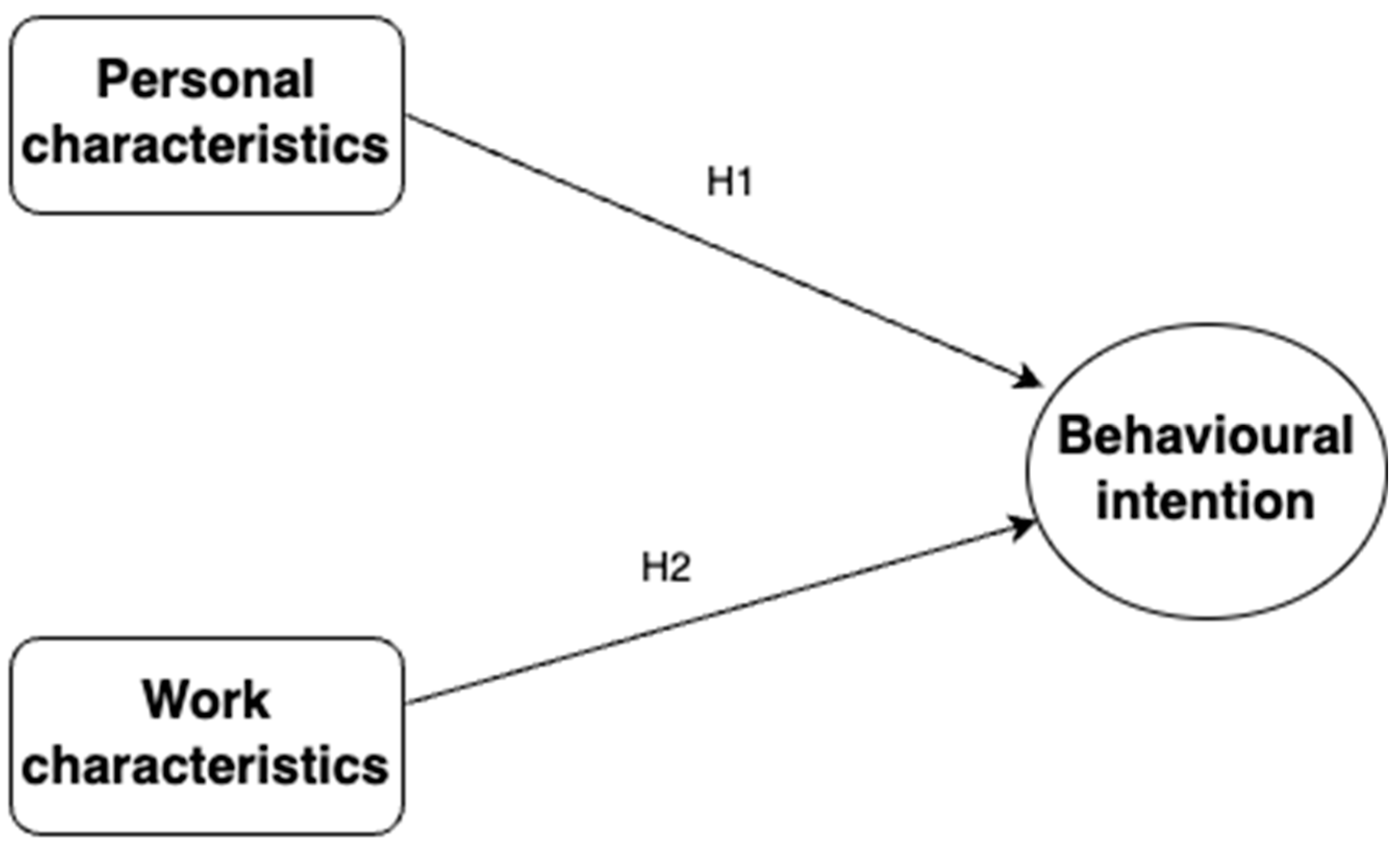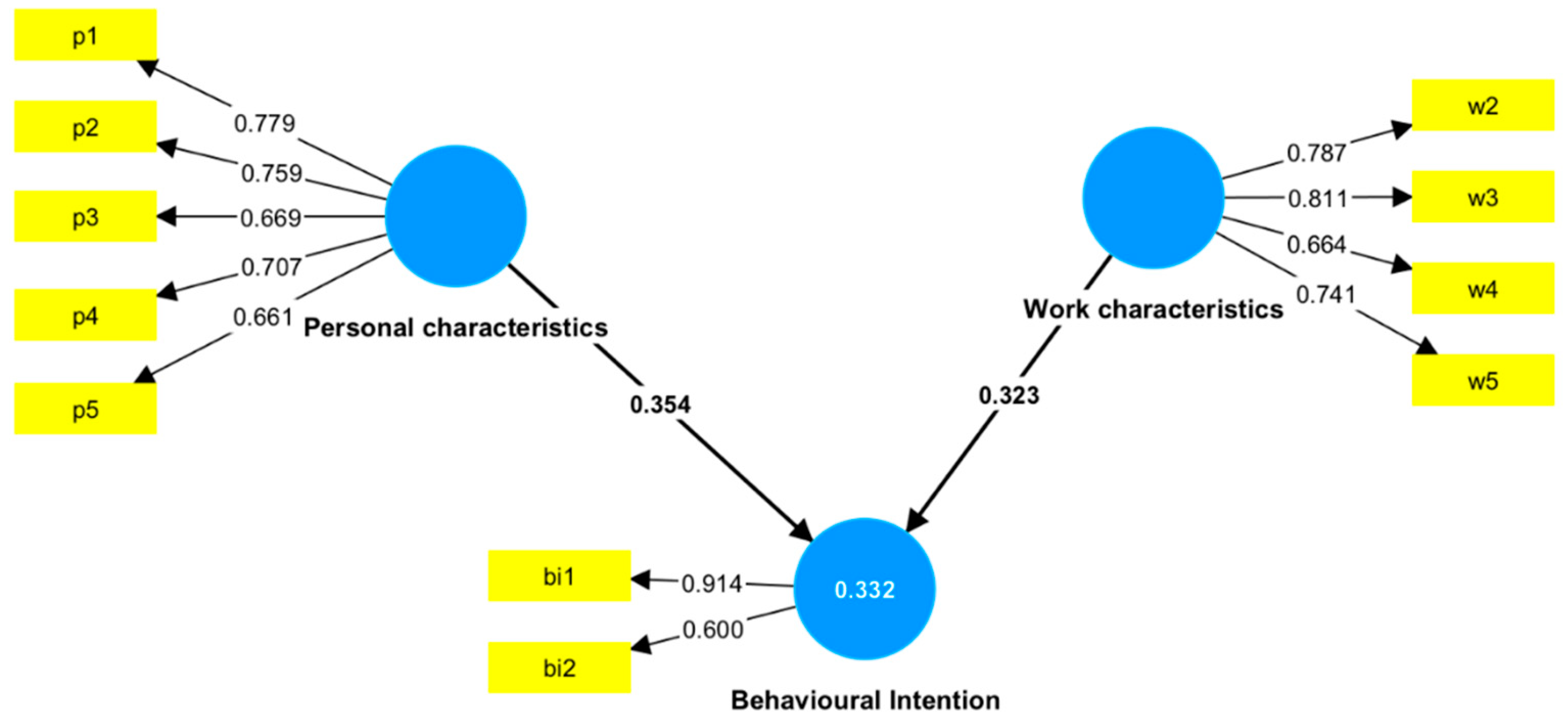Submitted:
21 June 2023
Posted:
21 June 2023
You are already at the latest version
Abstract
Keywords:
1. Introduction
2. Materials and Methods
2.1. Hypotheses Development
2.2. Respondents and measurement scales
- n is the required sample size
- p is the percentage occurrence of a state or condition
- E is the percentage maximum error required
- Z is the value corresponding to level of confidence required [35].
2.3. Data analysis
3. Results
3.1. Outer measurement model
3.2. Structure Model
4. Conclusions
Author Contributions
Funding
Informed Consent Statement
Data Availability Statement
Conflicts of Interest
References
- Behl, A.; Jayawardena, N.; Ishizaka, A.; Gupta, M.; Shankar, A. Gamification and gigification: A multidimensional theoretical approach. J. Bus. Res. 2021, 139, 1378–1393. [Google Scholar] [CrossRef]
- Mastercard, Fueling the global gig economy Mastercard, 2020.
- Rosenblat, A.; Stark, L. Algorithmic Labor and Information Asymmetries: A Case Study of Uber's Drivers. International Journal Of Communication 2016, 10, 27. [Google Scholar] [CrossRef]
- Tassinari, A.; Maccarrone, V. Riders on the Storm: Workplace Solidarity among Gig Economy Couriers in Italy and the UK. Work. Employ. Soc. 2019, 34, 35–54. [Google Scholar] [CrossRef]
- Anwar, M.A.; Graham, M. Between a rock and a hard place: Freedom, flexibility, precarity and vulnerability in the gig economy in Africa. Competition Chang. 2020, 25, 237–258. [Google Scholar] [CrossRef]
- Gregory, K. ‘My Life Is More Valuable Than This’: Understanding Risk among On-Demand Food Couriers in Edinburgh. Work. Employ. Soc. 2020, 35, 316–331. [Google Scholar] [CrossRef]
- Apouey, B.; Roulet, A.; Solal, I.; Stabile, M. Gig Workers during the COVID-19 Crisis in France: Financial Precarity and Mental Well-Being. J. Urban Heal. 2020, 97, 776–795. [Google Scholar] [CrossRef]
- Webb, R.M.S.R.A. Employment in the informal economy: implications of the COVID-19 pandemic. International Journal of Sociology and Social Policy 2020, 40, 1005–1019. [Google Scholar] [CrossRef]
- Al-Dossary, R. Investigating the feasibility of applying the gig economy framework in the nursing profession towards the Saudi Arabian Vision 2030. Informatics Med. Unlocked 2022, 30, 100921. [Google Scholar] [CrossRef]
- Hasegawa, Y.; Ido, K.; Kawai, S.; Kuroda, S. Who took gig jobs during the COVID-19 recession? Evidence from Uber Eats in Japan. Transp. Res. Interdiscip. Perspect. 2022, 13. [Google Scholar] [CrossRef]
- Melian-Gonzalez, S. Gig economy delivery services versus professional service companies: Consumers’ perceptions of food-delivery services. Technology in Society 2022, 69. [Google Scholar] [CrossRef]
- Ruthirakuhan, M.; Herrmann, N.; Vieira, D.; Gallagher, D.; Lanctôt, K.L. ; The Roles of Apathy and Depression in Predicting Alzheimer Disease: A Longitudinal Analysis in Older Adults With Mild Cognitive Impairment. Am. J. Geriatr. Psychiatry 2019, 27, 873–882. [Google Scholar] [CrossRef]
- Qiao, S.; Huang, G.; Yeh, A.G.-O. Who are the gig workers? Evidence from mapping the residential locations of ride-hailing drivers by a big data approach. Cities 2023, 132. [Google Scholar] [CrossRef]
- Christie, N.; Ward, H. Delivering hot food on motorcycles: A mixed method study of the impact of business model on rider behaviour and safety. Saf. Sci. 2023, 158. [Google Scholar] [CrossRef]
- Nilsen, M.; Kongsvik, T. Health, Safety, and Well-Being in Platform-Mediated Work – A Job Demands and Resources Perspective. Safety Science 2023, 163, 106130. [Google Scholar] [CrossRef]
- Nguyen-Phuoc, D.Q.; Nguyen, L.N.T.; Su, D.N.; Nguyen, M.H.; Oviedo-Trespalacios, O. Deadly meals: The influence of personal and job factors on burnout and risky riding behaviours of food delivery motorcyclists. Saf. Sci. 2023, 159. [Google Scholar] [CrossRef]
- Umair, A.; Conboy, K.; Whelan, E. UNDERSTANDING THE INFLUENCE OF TECHNOSTRESS ON WORKERS’ JOB SATISFACTION IN GIG-ECONOMY: AN EXPLORATORY INVESTIGATION. The 27th European Conference on Information Systems (ECIS), no. https://aisel.aisnet.org/ecis2019_rip/34, p. 34, 2019.
- Ruthirakuhan, M.; Herrmann, N.; Vieira, D.; Gallagher, D.; Lanctôt, K.L. The Roles of Apathy and Depression in Predicting Alzheimer Disease: A Longitudinal Analysis in Older Adults With Mild Cognitive Impairment. Am. J. Geriatr. Psychiatry 2019, 27, 873–882. [Google Scholar] [CrossRef]
- Andrea, M.; Petra, M.; Maryse, M.; Brita, S.; Amelie, L. We don't need no (higher) education - How the gig economy challenges the education-income paradigm. Technological Forecasting & Social Change 2023, 186, 122136. [Google Scholar]
- Dunn, M.; Munoz, I.; Jarrahi, M.H. Dynamics of flexible work and digital platforms: Task and spatial flexibility in the platform economy. Digit. Bus. 2023, 3. [Google Scholar] [CrossRef]
- Ewers, M.; Kangmennaang, J. New spaces of inequality with the rise of remote work: Autonomy, technostress, and life disruption. Applied Geography 2023, 152, 102888. [Google Scholar] [CrossRef]
- Woolley, K.; Fishbach, A. It’s about time: Earlier rewards increase intrinsic motivation. Journal of Personality and Social Psychology 2018, 114, 877–890. [Google Scholar] [CrossRef]
- Grant, A.M. Does intrinsic motivation fuel the prosocial fire? Motivational synergy in predicting persistence, performance, and productivity. Journal of Applied Psychology 2008, 93, 48–58. [Google Scholar] [CrossRef]
- Giurge, L.M.; Wooley, K. Working during non-standard work time undermines intrinsic motivation. Organizational Behavior and Human Decision Processes 2022, 170, 104134. [Google Scholar] [CrossRef]
- Dunn, M. Making gigs work: digital platforms, job quality and worker motivations. New Technology, Work and Employment 2020, 35, 232–249. [Google Scholar] [CrossRef]
- Zaman, U.; Nawaz, S.; Javed, A.; Rasul, T. Having a whale of a time: Linking self-determination theory (SDT), job characteristics model (JCM) and motivation to the joy of gig work. Cogent Bus. Manag. 2020, 7. [Google Scholar] [CrossRef]
- Xiongtao, H.; Wenzhu, L.; Haibin, L.; Shanshi, L. How Gig Worker Responds to Negative Customer Treatment: The Effects of Work Meaningfulness and Traits of Psychological Resilience. Front. Psychol. 2021, 12, 783372. [Google Scholar] [CrossRef]
- Futri, I.N.; Risfandy, T.; Ibrahim, M.H. Quota sampling method in online household surveys. Methodsx 2022, 9, 101877. [Google Scholar] [CrossRef]
- Moser, C.A.; Stuart, A. An Experimental Study of Quota Sampling. Journal of the Royal Statistical Society 1953, 116, 349–405. [Google Scholar] [CrossRef]
- Yoo, S.J.; Han, S.-H.; Huang, W. The roles of intrinsic motivators and extrinsic motivators in promoting e-learning in the workplace: A case from South Korea. Comput. Hum. Behav. 2012, 28, 942–950. [Google Scholar] [CrossRef]
- Slabbinck, H.; Witteloostuijn, A.V. Explicit and Implicit Basic Human Motives, and Public Service. Motivation Organizational Psychology 2020, 11. [Google Scholar] [CrossRef]
- Hackman, J.R.; Oldham, G.R. Development of the Job Diagnostic Survey. Journal of Applied Psychology 1975, 60, 159–170. [Google Scholar] [CrossRef]
- Dabić, M.; Maley, J.F.; Švarc, J.; Poček, J. Future of digital work: Challenges for sustainable human resources management. J. Innov. Knowl. 2023, 8, 100353. [Google Scholar] [CrossRef]
- S. Rahi, F.M.I. S. Rahi, F.M.I.Alnaser and M. A. Ghani, DESIGNING SURVEY RESEARCH: RECOMMENDATION FOR QUESTIONNAIRE DEVELOPMENT, CALCULATING SAMPLE SIZE AND SELECTING RESEARCH PARADIGMS in 37th International Scientific Conference on Economic and Social Development – Socio Economic Problems of Sustainable Development, Baku, 2019.
- Taherdoost, H. Determining Sample Size; How to Calculate Survey Sample Size. International Journal of Economics and Management Systems 2017, 2, 237–239. [Google Scholar]
- Alabdali, M.A.; Salam, M.A. The Impact of Digital Transformation on Supply Chain Procurement for Creating Competitive Advantage: An Empirical Study. Sustainability 2022, 14, 12269. [Google Scholar] [CrossRef]
- Seema, M.; Sachdeva, D. Moonlighting intentions of i.t. professionals: impact of organizational commitment and entrepreneurial motivation. Journal of Critical Reviews 2020, 7, 214–220. [Google Scholar] [CrossRef]
- H. Jr.Joseph.F, H.G. H. Jr.Joseph.F, H.G. M, R.C. M, S. Marko, D.N. P and R. Soumya, Partial Least Squares Structural Equation Modeling (PLS-SEM) Using R, Springer Nature, 2021.
- Bajunaied, K.; Hussin, N.; Kamarudin, S. Behavioral intention to adopt FinTech services: An extension of unified theory of acceptance and use of technology. J. Open Innov. Technol. Mark. Complex. 2023, 9. [Google Scholar] [CrossRef]
- Chen, T.; Song, W.; Song, J.; Ren, Y.; Dong, Y.; Yang, J.; Zhang, S. Measuring Well-Being of Migrant Gig Workers: Exampled as Hangzhou City in China. Behav. Sci. 2022, 12, 365. [Google Scholar] [CrossRef]
- Hair, J.F.; Ringle, C.M.; Sarstedt, M. Editorial - Partial Least Squares Structural Equation Modeling: Rigorous Applications, Better Results and Higher Acceptance. Long Range Planning 2013, 46, 1–12. [Google Scholar]
- Naveed, Q.N.; Alam, M.M.; Tairan, N. Structural Equation Modeling for Mobile Learning Acceptance by University Students: An Empirical Study. Sustainability 2020, 12, 8618. [Google Scholar] [CrossRef]
- Farrell, A.M. Insufficient discriminant validity: A comment on Bove, Pervan, Beatty, and Shiu (2009). Journal of Business Research 2010, 63, 324–327. [Google Scholar] [CrossRef]
- Cohen, J. A power primer. Psychological Bulletin 1992, 112, 155–159. [Google Scholar] [CrossRef]


| Measure | Item | Count | Percentage |
|---|---|---|---|
| Gender | Male | 162 | 49.5 |
| Female | 164 | 50.2 | |
| Other | 1 | 0.3 | |
| Age | 18-29 | 74 | 22.6 |
| 30-49 | 244 | 74.6 | |
| 50-65 | 9 | 2.8 | |
| 65+ | 0 | 0 | |
| Education | High school | 11 | 3.4 |
| College | 11 | 3.4 | |
| Bachelor | 160 | 48.9 | |
| Master | 141 | 43.1 | |
| Ph.D. | 4 | 1.2 | |
| Occupation | Student | 41 | 12.5 |
| Full-time employee | 222 | 67.9 | |
| Part-time employee | 31 | 9.5 | |
| Entrepreneur/Freelancer | 33 | 10.1 | |
| Total working hours per week | Less than 10h | 209 | 63.9 |
| 10-20h | 38 | 11.6 | |
| 21-40h | 58 | 17.7 | |
| 41-48h | 7 | 2.1 | |
| 49-60h | 5 | 1.5 | |
| More than 60h | 10 | 3.1 | |
| Desire to work as a gig now/ future | Yes | 303 | 92.7 |
| No | 24 | 7.3 |
| Item | Loading | CA | rho_a | rho_c | AVE | |
|---|---|---|---|---|---|---|
| Behavioral Intention | Bi1 | 0.914 | 0.767 | 0.773 | 0.741 | 0.598 |
| Bi2 | 0.600 | |||||
| Personal characteristics | P1 | 0.779 | 0.764 | 0.772 | 0.840 | 0.514 |
| P2 | 0.759 | |||||
| P3 | 0.669 | |||||
| P4 | 0.707 | |||||
| P5 | 0.661 | |||||
| Work characteristics | W2 | 0.787 | 0.746 | 0.760 | 0.839 | 0.567 |
| W3 | 0.811 | |||||
| W4 | 0.664 | |||||
| W5 | 0.741 |
| Behavioural Intention | Personal characteristics | Work characteristics | |
|---|---|---|---|
| Behavioral Intention | |||
| Personal characteristics | 0,834 | ||
| Work characteristics | 0,484 | 0,590 |
| Behavioural Intention | Personal characteristics | Work characteristics | |
|---|---|---|---|
| Behavioural Intention | 0,773 | ||
| Personal characteristics | 0,499 | 0,717 | |
| Work characteristics | 0,481 | 0,447 | 0,753 |
| VIF | |
|---|---|
| Personal characteristics -> Behavioral Intention | 1.250 |
| Work characteristics -> Behavioral Intention | 1.250 |
| Hypothesis | Std Beta | T-Statistics | p-Value | F square | Effect size | Decision |
|---|---|---|---|---|---|---|
| H1: PC | 0.354 | 6.376 | 0.000 | 0.150 | Medium | Supported |
| H2: WC | 0.323 | 5.839 | 0.000 | 0.325 | Medium | Supported |
Disclaimer/Publisher’s Note: The statements, opinions and data contained in all publications are solely those of the individual author(s) and contributor(s) and not of MDPI and/or the editor(s). MDPI and/or the editor(s) disclaim responsibility for any injury to people or property resulting from any ideas, methods, instructions or products referred to in the content. |
© 2023 by the authors. Licensee MDPI, Basel, Switzerland. This article is an open access article distributed under the terms and conditions of the Creative Commons Attribution (CC BY) license (http://creativecommons.org/licenses/by/4.0/).




